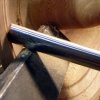- Joined
- Aug 15, 2006
- Messages
- 2
- Likes
- 0
Please help!!!!!!!!!!! No matter what I do I continually have torn end grain in bowls that I am turning. It doesnt' seem to matter what the wood is, what gouge I use, shear scraping, praying, begging, or pleading it still tears out and all I do is sand and sand some more. Yes the tools are sharp. Any suggestions???????????/ :mad:

